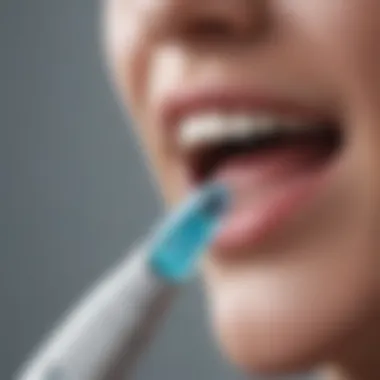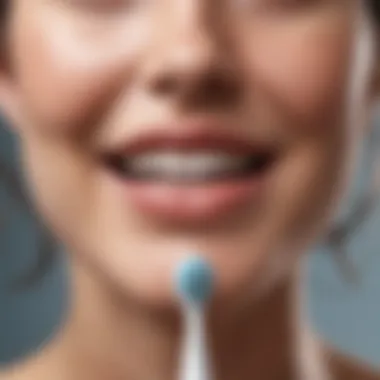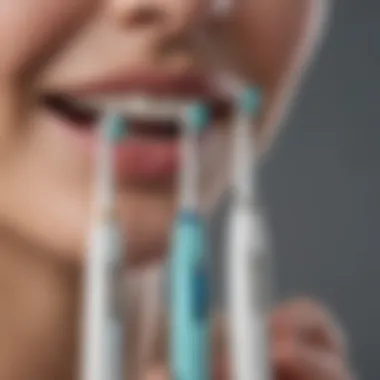Top Electric Toothbrushes for Sensitive Gums


Intro
Selecting the right electric toothbrush can feel like navigating a minefield, especially for those dealing with sensitive gums. It’s not just about cleaning teeth; it’s about enhancing your overall oral health while making sure you’re not sending shockwaves of discomfort through your mouth. That's where this guide comes in.
Electric toothbrushes come packed with features tailored for specific needs. For sensitive gums, it’s not just about the brute force of brushing but about gentle care and precision. Pressure sensors, specifically designed brush heads, and different cleaning modes can make a world of difference.
In this article, we’re going to dive deep into important characteristics you should consider when looking for an electric toothbrush suited for your tender gums. We'll spotlight leading products, share user experiences, and more, ensuring you have enough information to make a sound decision for your dental care.
When it comes to oral hygiene, overlooking your gum health is like throwing a party in a house that's about to collapse – it just doesn’t make sense. It’s crucial to choose a toothbrush that not only keeps your teeth sparkling but also protects your gums, helping to stave off potential gum disease and other complications. Let's roll up our sleeves and get into it.
Understanding Sensitive Gums
When it comes to oral care, having an understanding of sensitive gums is crucial. Many individuals experience gum sensitivity at some point in their lives, yet this condition is often underestimated. Knowing what it is, what causes it, and how to manage it can dramatically improve one’s dental hygiene and overall comfort.
Sensitive gums can lead to discomfort while brushing or eating. This discomfort can deter people from maintaining their best oral hygiene, potentially leading to more severe dental issues down the line. Moreover, gum sensitivity can also be a sign of other underlying health problems, meaning being aware of the nuances surrounding gums is more than just a matter of convenience; it’s essential for well-being.
The Anatomy of Gums
Gums, also known as gingiva, play a vital role in oral health. They surround and protect the underlying bone structure and tissues that hold teeth in place. Healthy gums are firm, pink, and fit snugly around the teeth.
Anatomically, gums consist of several key parts:
- Marginal gingiva: The edge of the gums that forms a collar around each tooth.
- Attached gingiva: The portion of the gum that is firmly bonded to the underlying bone.
- Interdental papillae: These are the gum tissues that fill the spaces between teeth, helping to prevent food from getting stuck.
When any part of this structure becomes compromised, it can lead to issues like sensitivity, inflammation, and even periodontal disease. Thus, understanding gum anatomy is foundational to grasping why some people might experience unusual tenderness.
What Causes Gum Sensitivity?
Gum sensitivity is triggered by various factors. Here are some of the most common causes:
- Aggressive brushing or flossing: Using too much force can wear down the gum tissue
- Poor oral hygiene: Neglecting to brush or floss adequately can lead to plaque buildup, resulting in gum inflammation
- Hormonal changes: Women may experience heightened gum sensitivity during menstruation, pregnancy, or menopause due to hormonal fluctuations
- Nutritional deficiencies: Lack of Vitamin C, for instance, can lead to weakened gums and increased sensitivity
Determining the root cause can assist in not just alleviating the pain but also in preventing further gum damage. Understanding that gum sensitivity is multifaceted can help individuals approach their dental routine with care and consideration.
Signs and Symptoms of Sensitive Gums
Recognizing the signs and symptoms of sensitive gums is essential for timely intervention. Common indicators include:
- Discomfort or pain when brushing or eating hot, cold, or spicy foods
- Gums that bleed easily during brushing or flossing, a sign of inflammation
- Swelling or redness around the gum line, indicating irritation
- Receding gums that expose more of the tooth than normal
Understanding these warning signs allows for immediate attention before issues worsen.
If you notice these symptoms, it may be time to reevaluate your brushing techniques or consult with a dental professional. Recognizing gum sensitivity and addressing its causes can lead to significant improvements in oral health and comfort.
The Role of Electric Toothbrushes in Oral Care
In recent years, the landscape of oral hygiene has seen a significant shift toward the adoption of electric toothbrushes. This transition has been fueled by a growing understanding of dental health and new technologies designed to enhance the brushing experience. Electric toothbrushes are not just about convenience; they have specific benefits that cater to individuals with sensitive gums.
One crucial aspect is the efficiency of plaque removal. Electric toothbrushes tend to outperform manual brushes in terms of cleaning power. The rapid motion of the bristles helps �agitate the plaque more effectively, reducing the amount left on the teeth and gums. Brushing with an electric toothbrush requires less effort, which is particularly beneficial for individuals who may struggle with conventional brushing due to discomfort or limited dexterity.


Moreover, these devices often come packed with features tailored to improve user experience and promote better oral health. Settings can be adjusted to suit individual needs and preferences, especially for those suffering from gum sensitivity. Understanding the role these toothbrushes play is more than just a passing trend; it's about understanding how they contribute to comprehensive oral care strategies.
Benefits Over Manual Toothbrushes
- Superior plaque removal: Due to their oscillating or rotating functions, electric toothbrushes can clean teeth more effectively than manual brushing.
- Ease of use: For those with limited hand strength or coordination, electric models require less physical effort.
- Built-in timers: Many electric toothbrushes have timers that ensure users brush for the recommended two minutes, promoting better habits.
- Pressure control: Some models alert users when they're applying too much pressure, which is crucial for sensitive gums.
Key Features to Look For
To select an electric toothbrush that is right for sensitive gums, there are specific features that should not be overlooked.
Sensitive Modes
Sensitive modes are specially designed settings that typically lower the intensity and speed of the brush. This mode is an excellent choice for those who experience discomfort while brushing. It provides just the right balance to ensure a gentle yet effective cleaning. Users often find that these modes decrease gum irritation, allowing for a more pleasant experience overall. Some models offer customizable settings, giving the user control over their brushing pressure.
Furthermore, this specialized mode emphasizes gentle cleaning without sacrificing efficacy, allowing users to maintain great oral hygiene without the discomfort.
Pressure Sensors
Pressure sensors are integrated into many modern electric toothbrushes, serving as an invaluable tool for protecting sensitive gums. These sensors alert users if they are brushing too hard, which can lead to gum recession and damage over time. The key characteristic of these sensors is their ability to provide real-time feedback, encouraging users to adopt healthier brushing habits. When a user applies excessive force, the toothbrush may halt its motion or reduce power, helping to mitigate the risk of injury. This technology is highly beneficial for anyone with gum sensitivity, as it fosters a more mindful approach to oral care.
Brush Head Variations
The diversity in brush head designs available today is another noteworthy feature of electric toothbrushes. Different shapes, sizes, and bristle textures cater to individual needs, particularly for those with sensitive gums. Selecting the right brush head might involve experimenting with a few options to find the best fit. Soft bristles can provide a gentler touch without compromising on cleaning effectiveness. Some heads are specifically designed to target hard-to-reach areas, enhancing overall oral hygiene. Being able to switch out brush heads allows users to customize their brushing experience and adapt to any changes in sensitivity or gum health.
By understanding the role of electric toothbrushes in oral care and their unique features, individuals can make informed choices that enhance their primary goal: maintaining healthy gums and teeth. As these devices continue to evolve, they hold great promise for easing the experience of brushing and delivering optimal oral health outcomes.
Top Electric Toothbrushes for Sensitive Gums
When it comes to choosing the right electric toothbrush for sensitive gums, making an informed decision is crucial. Sensitive gums can affect overall oral health, leading to discomfort and sometimes, more serious dental issues. Electric toothbrushes can offer a gentle yet effective cleaning experience, which is particularly beneficial for those with tenderness in their gums. In this section, we'll explore specific products that excel in catering to this need while also addressing essential features and user experiences.
Product Reviews
Brand A: Overview and Features
Brand A has carved out a niche in the field of electric toothbrushes with its user-friendly design and technology aimed at sensitive gums. One notable aspect of Brand A’s toothbrush is its gentle cleaning modes, specifically created to provide effective brushing without causing irritation. This feature makes it a popular choice among individuals who experience discomfort when using traditional brushes.
The unique smart pressure sensor in Brand A's model is another plus. It lets users know if they're pressing too hard, which is an important consideration for preventing gum recession and sensitivity. While the price point may be a bit on the higher side, many find the investment worth it due to its durability and effectiveness in managing gum sensitivity.
Brand B: User Experiences
Moving to Brand B, one of the standout features is its user-friendly interface that ensures even those who aren't tech-savvy can enjoy its benefits. Users frequently commend its gentle brushing experience, which minimizes any potential discomfort during use. The alignment of the brush head is specially designed to reach tricky spots without damaging tender gum areas.
From various user reviews, a common advantage is the long battery life, which means less time fussing over charging and more time enjoying a healthier mouth. However, as with any products, some users note that the brushes may require more frequent head replacements, which is something to keep in mind.
Brand C: Cost vs. Benefits
Brand C presents an appealing option for those considering the cost versus benefits of electric toothbrushes for sensitive gums. One of its claims to fame is its affordable pricing compared to competitors while still offering a variety of settings tailored for different needs, including sensitive modes.
The toothbrush comes equipped with advanced timer features, which encourage users to brush for the dentist-recommended two minutes. Though it lacks some high-end features found in pricier models, many users appreciate that it still accomplishes effective cleaning without breaking the bank. The key here is balancing price without sacrificing quality, making it a solid choice for many.
Comparative Analysis


Ease of Use
Considering ease of use, it's imperative that an electric toothbrush is accessible, especially for those with sensitive gums. All three brands discussed here score well in this category, yet Brand A stands out slightly with its intuitive interface and streamlined settings, making it a breeze to operate.
Users often point out the lightweight design of these brushes, allowing for easy maneuverability during brushing. However, Brand C also offers a commendable design, particularly for individuals who may have dexterity issues.
Cleaning Efficacy
When it comes to cleaning efficacy, all three brands boast impressive results with regular use. Brand B is particularly noted for its ability to effectively dislodge plaque without being harsh on the gums. The oscillating head design can reach those awkward corners of your mouth, reducing the chances of leaving behind any sticky plaque.
While Brand C may not have all the bells and whistles, it still performs adequately well, especially in maintaining good gum health, yet it may not deliver the same deep clean as some pricier models. Users need to assess what cleaning power they prioritize in their routine.
Durability
Finally, durability is a key factor in the long-term value of any electric toothbrush. Brand A takes the cake here, with robust materials designed to withstand continuous use, plus a reputation for quality that is rarely contested. The waterproof design adds an additional layer of protection against damage.
In contrast, Brand B provides a solid, reliable toothbrush, though some users mention occasional issues with the charging mechanism after prolonged use. Brand C, while cost-effective, may require more careful handling since it is built from lighter materials and may be more prone to wear and tear.
Proper Usage Techniques for Electric Toothbrushes
Using an electric toothbrush effectively can make a world of difference, especially for those grappling with sensitive gums. Understanding the correct techniques not only enhances cleaning efficiency but also minimizes the risk of aggravating existing gum issues. The importance of technique cannot be overstated; improper use may lead to discomfort or worsen sensitivity, negating the benefits of investing in a quality product.
Effective Brushing Techniques
Mastering effective brushing techniques is paramount for optimal results. One of the most significant tips is to let the toothbrush do the work. Pressing down too hard can cause undue pressure on sensitive gums, which can lead to pain and irritation. Instead of scrubbing, use gentle, circular motions to tackle plaque and debris. You should aim for a light touch that allows the bristles to glide over your gums and teeth—think of it as a soft dance rather than a vigorous workout.
Another critical aspect is to divide your mouth into quadrants, spending about 30 seconds on each section. This systematic approach ensures that no area is neglected. Pay extra attention to the gum line, where plaque tends to accumulate. And don't forget to brush your tongue gently, as it can harbor bacteria that contribute to bad breath.
Key Points for Effective Brushing:
- Light pressure is crucial to protect sensitive gums.
- Use gentle, circular motions.
- Divide your mouth into quadrants for focused cleaning.
- Brush for at least two minutes, maintaining consistency.
"Using the right technique can transform your brushing experience from a chore into a simple, soothing ritual."
Frequency and Duration of Use
Establishing the right frequency and duration is equally vital. Most dentists recommend brushing at least twice a day. Morning and night routines can make a significant impact on gum health, particularly for those with sensitivity. Regular brushing not only removes plaque but also helps to fortify gum tissues due to increased blood flow.
When it comes to duration, aim for a minimum of two minutes each time. While this may sound daunting at first, setting a timer or using a toothbrush with a built-in timer can help maintain accountability. Many electric toothbrushes have a feature that buzzes or pauses after two minutes, providing guidance on effective usage.
Additionally, if your gums feel tender, consider reducing the pressure or frequency temporarily until they feel stronger. Your mouth is not a race track; patience is essential. Listen to your body, as it often knows best.
Suggestions for Frequent and Duration Practices:
- Brush twice daily, preferably at intervals.
- Aim for at least two minutes of brushing time each session.
- Employ timers for consistency in practice.
- Adjust your routine based on gum sensitivity and feedback from your teeth.
By incorporating these practices into your dental hygiene routine, you create a healthier environment for your gums and improve your overall dental health. Remember, taking few extra minutes with proper techniques can yield long-term benefits. Your smile and your gums will surely thank you.
Maintaining Your Electric Toothbrush
Caring for your electric toothbrush is more than just an afterthought - it is an essential part of ensuring that your dental hygiene remains at its best. An electric toothbrush, particularly for individuals with sensitive gums, acts almost like a safety net against gum disease and discomfort. When you properly maintain this tool, it functions optimally to provide gentle yet effective cleaning. Not only does maintenance prolong the life of your toothbrush, but it also ensures that you're getting the most out of the device itself.


Regular upkeep can also mitigate the buildup of bacteria, which can lead to infections or other oral health issues. Remember, a clean toothbrush head is crucial for an effective clean, particularly when your gums require a soft touch.
Frequency of Brush Head Replacement
When it comes to brush head replacement, most brands recommend changing the head every three months. However, if you notice the bristles starting to fray or change color, it’s a sign it's time to swap out that brush head.
Here’s why frequency matters:
- Efficacy: Worn-out bristles can't do their job effectively. A new brush head ensures that those sonic vibrations reach every nook and cranny in your mouth.
- Hygiene: Bacteria can accumulate on frayed bristles. Old brush heads become a breeding ground for germs.
- Sensitivity: Using a fresh brush head can lessen irritation on sensitive gums. Softer, new bristles tend to be gentler and therefore less likely to aggravate your condition.
Cleaning and Care
Keeping your electric toothbrush clean is as vital as replacing the brush head. A routine cleaning regimen will not only keep it looking fresh but also encourage better oral hygiene.
- Rinse after Use: After brushing, make sure to rinse the brush head thoroughly under warm water to remove any toothpaste or debris. This simple step drastically cuts down on bacteria.
- Disinfect the Brush Head: Every week or so, soak the brush head in a mixture of equal parts water and white vinegar for a good 10 minutes. This natural disinfectant can effectively kill bacteria and give your brush head a longer life.
- Store Properly: Store your toothbrush upright and let it air-dry. Avoid keeping it in a closed container, as moisture can encourage bacterial growth.
- Avoid Contact: Keep your toothbrush separate from others to avoid cross-contamination. It’s tempting to toss them in a drawer together, but keeping them apart may save you from unwanted germs.
Exploring Other Factors for Gum Health
Gum health is influenced by a variety of elements beyond just brushing techniques and having a proper electric toothbrush. In fact, several lifestyle choices and habits can help bolster the health of your gums and overall oral hygiene. Understanding these factors offers valuable insights for those with sensitive gums, allowing individuals to develop a well-rounded approach to maintain their oral health. We'll probe into three crucial components: diet, regular dental checkups, and alternative hygiene practices.
Diet and Its Impact
The saying "you are what you eat" holds more weight than one might realize, especially when it comes to gum health. A balanced diet rich in vitamins and minerals can directly affect gum health and, subsequently, your overall well-being.
- Vitamin C: This vitamin is essential for the production of collagen, a key component of gum tissue. Foods like oranges, strawberries, and green peppers can help keep your gums strong and resistant to inflammation.
- Calcium and Phosphorus: Found in dairy products and leafy greens, these minerals play a role in maintaining strong teeth and bones. When the gums are healthy, teeth tend to be healthier too.
- Omega-3 Fatty Acids: These can reduce inflammation and are found in fatty fish like salmon, walnuts, and flaxseeds.
- Limit Sugary Foods: Frequent consumption of sugar can lead to plaque buildup, ultimately causing gum issues. Cutting back on candies and sodas can dramatically improve gum health.
Maintaining a balanced diet not only supports your gums but can make a world of difference in preventing deterioration and sensitivity.
Importance of Regular Dental Checkups
Third on the list is regular dental checkups. Many people might consider them an inconvenience, but neglecting these appointments can lead to more hefty issues down the road. The consequences of skipping out can be significant, especially for individuals with sensitive gums.
- Professional Cleaning: Dentists and hygienists can remove plaque and tartar that regular brushing may miss. This is crucial in preventing gum disease, which can exacerbate sensitivity.
- Monitoring Changes: Regular visits allow dental professionals to detect any shifts in gum health before they escalate into something requiring more serious treatment. Early detection can save a lot of pain and expense.
- Customized Advice: Every individual has unique needs when it comes to oral health. Dentists can provide specific recommendations tailored to your situation, which an online guide might not cover.
Getting into the habit of regular checkups could just be one of the best investments in your gum health.
Alternative Hygiene Practices
Besides the standard brushing and flossing, incorporating alternative hygiene practices can further improve gum health and create a solid routine for sensitive gums.
- Oil Pulling: This ancient practice involves swishing oil (often coconut or sesame) in your mouth for 15-20 minutes. It can help absorb harmful bacteria and promote healthier gums.
- Tongue Scraping: Often overlooked, this practice removes bacteria and food particles from the surface of your tongue, which can contribute to oral bacteria levels if not addressed.
- Salt Water Rinses: A warm salt water rinse can soothe inflamed gums and speed up the healing process in minor gum issues.
- Tea Tree Oil: Known for its antimicrobial properties, a drop of tea tree oil in your daily oral care routine can contribute to a healthier mouth.
Incorporating these alternative practices into your routine may feel cumbersome initially, but many people report noticeable improvements in their gum health after doing so over time.
Adopting these practices alongside using a suitable electric toothbrush can create a comprehensive strategy for maintaining your gum health. A holistic approach that caters to multiple aspects can yield better results than a singular focus.
Culmination
In closing, it’s clear that the choice of an electric toothbrush can significantly impact the health of individuals with sensitive gums. The right electric toothbrush not only alleviates discomfort but can also enhance overall oral hygiene by effectively removing plaque without causing further irritation. Understanding the necessity of specific features like pressure sensors and gentle brushing modes is paramount. A toothbrush that caters to sensitive conditions promotes a more pleasant experience, ensuring that brushing becomes a routine that patients look forward to rather than a chore.
Recap of Essential Points
- Sensitivity is Real: Sensitive gums can be a source of pain and anxiety, prompting the need for specialized care.
- Electric vs. Manual: Electric toothbrushes provide a gentle and effective way to maintain oral hygiene, surpassing traditional methods in many instances.
- Essential Features to Consider: Look for models that offer features tailored to sensitive gums, including pressure sensors that reduce harsh contact and variations in brush head design to lessen discomfort.
- Regular Maintenance Matters: Changing brush heads and maintaining the device is critical for effective performance and hygiene.
- Other Factors: Diet and regular dental visits play a substantial role in gum health.
Final Thoughts on Electric Toothbrush Selection
Despite the plethora of options available on the market, choosing the right electric toothbrush comes down to personal needs and preferences. It’s advantageous to invest time in comparing different models, keeping an eye out for user reviews and expert recommendations. As every person’s gum sensitivity differs, identifying an electric toothbrush that feels comfortable and aligns with one’s dental care routine is vital. Ultimately, selecting the best tool for the job can transform not just oral health but also overall well-being by offering a pain-free brushing experience. Remember, a small investment in your oral hygiene today can lead to a brighter and healthier tomorrow.







